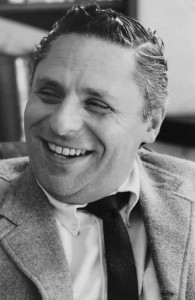Al Brodax, a television producer who delivered an enduring psychedelic classic when he turned the Beatles song “Yellow Submarine” into an animated film in 1968, died on Thursday in Danbury, Conn. He was 90.
The death was confirmed by his daughter, Jessica Harris.
In the 1960s, Mr. Brodax (pronounced BROH-dax) ran the motion picture and television division of King Features Syndicate, where he produced hundreds of “Popeye” cartoons for television.
Quick to see the cartoon potential of the Beatles, he sold their manager, Brian Epstein, on the idea of an animated series. “The Beatles” ran on Saturday mornings on ABC from 1965 to 1969 (in reruns for the last two years), attracting huge audiences. When “Yellow Submarine” climbed the charts in 1966, Mr. Brodax sensed that lightning might strike twice.
He approached Mr. Epstein again, this time with some trepidation; the Beatles did not like “The Beatles.”
But there was an opening. The group owed United Artists one more film after “A Hard Day’s Night” and “Help!,” but had lost interest in acting. An animated film, Mr. Brodax argued, would require virtually no participation by the Beatles and satisfy the conditions of their contract.
“All they had to do was sign a piece of paper,” he told the website 21st Century Radio in 1994. “I’d do the work.”
A deal was struck. Mr. Brodax put together a team of writers and animators who, despite constant friction and turmoil and a slender budget of $1 million, created a small miracle: a Popsicle-colored fantasia devoted to peace, love and the thrilling pulse of the Beatles’ music.
Source: New York Times
Mr. Brodax put together a team of writers and animators who, despite constant friction and turmoil and a slender budget of $1 million, created the film “Yellow Submarine.” CreditSubafilms, via Reuters
Songs from the albums “Rubber Soul,” “Revolver” and “Sgt. Pepper’s Lonely Hearts Club Band,” as well as four new songs, provided much of the soundtrack. The dialogue was spoken by actors from Liverpool.
The film, which The Boston Globe in 1987 called “a big post-Summer-of-Love rainbow head trip,” appealed to adults and children alike. Directed by George Dunning with a swirling, pulsating psychedelic visual style created by the Czech-born illustrator Heinz Edelmann, it sent the four Beatles on a submarine voyage to idyllic Pepperland while being threatened by the music-hating, color-draining Blue Meanies.
Apple Bonkers, Snapping Turks and the Dreadful Flying Glove menaced the group, but, disguised as Sgt. Pepper’s Lonely Hearts Club Band, the Beatles vanquished the enemy with their music. Once the Beatles saw the final version, they warmed to it and filmed a brief live-action coda.
The film critic Roger Ebert, writing about a restored version released in 1999, called it “a music-based animated film for the ages,” with “a freedom of color and invention that never tires.”
Albert Philip Brodax was born on Feb. 14, 1926, in Manhattan. His father, Herman, was a coat manufacturer. His mother, the former Lillian Joss, was a homemaker.
He grew up in Washington Heights and, after the family moved to Brooklyn, attended Midwood High School.
More essential than ever.
He enlisted in the Army in 1943 and served as a medic. He was wounded during the Battle of the Bulge, earning a Purple Heart, a Bronze Star and a Combat Medical Badge.
After returning to the United States, he studied English literature at the University of Wisconsin. He received a bachelor’s degree in 1948.
He found work in the mailroom of the William Morris Agency in New York and rose to become a television writer and producer, assigned to “Your Show of Shows” and “Omnibus.” He also helped produce a Broadway adaptation of Sherwood Anderson’s book “Winesburg, Ohio” in 1958.
In 1951, he married Joan Greenberg, who survives him. In addition to her and his daughter, he is survived by his sons, Daniel and Douglas; a sister, Myrna Kurtz; and six grandchildren.
Mr. Brodax was hired by King Features Syndicate in 1960 to run its new motion picture and television division. After producing 220 “Popeye” cartoons, he collaborated with Bob Kane, the creator of “Batman,” on the animated spy spoof “Cool McCool” and produced television versions of the comic strips “Krazy Kat,” “Beetle Bailey,” “Snuffy Smith” and “Barney Google.”
“Yellow Submarine” was fraught with difficulties. Mr. Epstein, notoriously difficult to work with in his later years, rejected every script that Mr. Brodax presented to him, including one by the novelist Joseph Heller, objecting to the colored binders they came in.
Mr. Brodax commissioned a young playwright, Lee Minoff, to come up with a new script, which underwent radical revisions but included some of the basic elements of the final product. The script doctors called in for revisions included Erich Segal, who later wrote “Love Story,” and the Liverpool writer and musician Roger McGough, who added the absurdist puns sprinkled throughout the film.
The members of the visual team, for their part, took creative license, adding their own plot elements and more or less running amok. Mr. Brodax, to his credit, went with the flow.
“Al was a real innocent who didn’t know how he got what he got,” Peter Sander, one of the animators, told The Toronto Star in 1987. “But he got it.”
“Yellow Submarine” won an award from the New York Critics Circle for achievement in full-length animation.
Mr. Brodax went on to produce a short-lived live-action television series based on the comic strip “Blondie” before leaving King Features for ABC. There he produced the Sunday-morning children’s shows “Make a Wish” and “Animals, Animals, Animals.”
In the 1980s, he worked as a consultant for Marvel Comics and Computer Graphics Laboratories.
His book “Up Periscope Yellow: The Making of the Beatles Yellow Submarine” was published in 2004.



